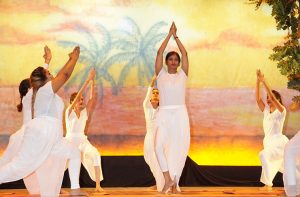By Tajeram Mohabir
IN the beginning there was darkness and from darkness emerged light with the sound ‘Om,’ which gave rise to words of knowledge compiled in sacred books referred to as the Vedas.
According to one of the Vedas, the Rigveda, one of the branches of knowledge that flowed from the fountain of elevated learning was yoga.
Yoga, since time immemorial, has been revered as the sacred art and science geared at uniting the body and mind to attain self-realisation.
The word yoga is mentioned in ancient seminal Hindu texts such as the Rigveda, the Upanishads, the Ramayana, the Mahabharatha and the Bhagavad Gita.
The Bhagavad Gita is literally a book on yoga and an inspiration behind Indian Freedom Fighter Mahatma Gandhi’s non-violence movement that ended British rule in India.
Though it is known that the word yoga is Sanskrit in origin, and when translated to English means “to join together” or to “unite,” the date when this spiritual practice began is unknown.
However, some scholars, based on archaeological finds, believe that the practice of yoga began some 5,000 years ago; but others have expressed different views, with some contending that the discipline is way much older and dates back to about 10,000 years ago.
According to the Morarji Desai National Institute of Yoga, one of the leading yoga centres of higher learning in India, yoga can be traced to the Indus Saraswati Valley civilisation around the year 2700 BC.
This prestigious school bases its assumption on discoveries of motifs, figures, seals and other items excavated in the Indus Valley region.
The International Centre for Yoga Education and Research (ICYER) has however pointed out that the culture of the Indus Valley civilisation is more than 9,000 years old, and as such, it is likely that yoga began more than 5,000 years ago.
LOST IN ANTIQUITY
Like the date of origin which is lost in antiquity, the circumstance(s) that gave birth to this ancient practice is also unknown, but could have been due to a great absence in spiritual consciousness of the Indus Valley inhabitants at the time, or happens to be a product derived from continuous learning.
The very fact that a date of origin and cause of establishment of this widely practised spiritual discipline are unknown, underscores two simple important points. One, yoga is a very ancient practice and two, its founders and early practitioners had to be a people of an advanced civilisation.
Today, millennia after, their descendants have not only preserved this inner engineering science, but have spread it around the world where it is widely practised, including by millennials seeking inner peace from the daily stresses and travails of life.
Agnela Patil, an Indian national who hails from Goa, a former Portuguese colony in India, is a yoga teacher at the Swami Vivekananda Cultural Centre, formerly the Indian Culture Centre.
EIGHT-FOLD PATHS
She told the Guyana Chronicle that yoga is practised through eight-fold paths as outlined by sage of olden times, Pantanjali, who after studying various yoga texts, documented his work in a book, Pantanjali Yoga Sutras.
Modern-day yoga scholar Ananda Balayogi Bhavanani, in a paper titled: ‘The History of Yoga from Ancient to Modern Times,’ identified the eight-fold paths as Yama, Niyama, Asana, Pranayama, Pratyahara, Dharana, Dhyana and Samadhi.
Yama, involves attitudes toward the environment; Niyama, the attitudes toward oneself; Asana, the physical postures and stretches done; Pranayama, the restraint or expansion of the breath; Pratyahara, the withdrawal of the senses; Dharana, the concentration required; Dhyana, meditation; and Samadhi, the spiritual connection which involves a meditative consciousness.

Patil said contrary to what some believe, even though yoga was birthed in India, a country with a population today of 1.3 billion people, about 80 per cent are Hindus; yoga is not about religion, but the art of living and it is more than just exercises.
“Yoga is a universal practice; it is not related to religion, caste or creed, and so anyone can join a yoga session. Some consider yoga as a mere exercise; however, yoga is more than that. It is the integration of the mind, body and spirit into one harmonious whole. It strives for attaining inner peace and union with the environment by means of quietening the constant chatter of the mind, creating a healthy body and being at peace with who you are and the world around you. Achieving this harmony is at the core of yoga,” she said.
POSITIVE EFFECT
Not downplaying yoga exercises, Patil noted that they do have a positive effect on the practitioner’s health, fitness and general well-being.
Her claim is support by an article published by Harvard Medical School titled “The physical benefits of yoga”.
The article grounded in research, stated that yoga promotes physical health in many ways as it helps in stress management, promotes flexibility and reduces joint pain.
Former President Donald Ramotar, a yoga practitioner, speaking at a recent event testified that yoga has helped him to overcome daily stresses as well as a nagging back pain.
The Harvard Medical School article also noted that yoga may help with migraines, osteoporosis, balance and mobility issues, multiple sclerosis, inflammatory bowel disease, fibromyalgia, and Attention Deficit Hyperactivity Disorder (ADHD).
According to Patil, through constant practice, yoga would enable the practitioner to enjoy holistic health, happiness and harmony.
Her sentiments are captured in a pitch by Indian Prime Minister, Narendra Modi, who on September 27, 2014, proposed to the international community at the United Nations to adopt a day to observe yoga.
“Yoga is an invaluable gift of ancient Indian tradition. It embodies unity of mind and body; thought and action; restraint and fulfilment; harmony between man and nature and a holistic approach to health and well-being. Yoga is not about exercise, but to discover the sense of oneness with ourselves, the world and nature,” the prime minister told the UN General Assembly.
On December 11, 2014, the UN General Assembly unanimously approved a resolution to establish June 21 as International Day of Yoga.
Today, Guyana will be celebrating International Day of Yoga at the Everest Cricket Club, Georgetown at 10.00 hrs. The day will also be observed at the Indian Arrival Monument, Palmyra, Berbice on June 23 at the same time.



.jpg)









